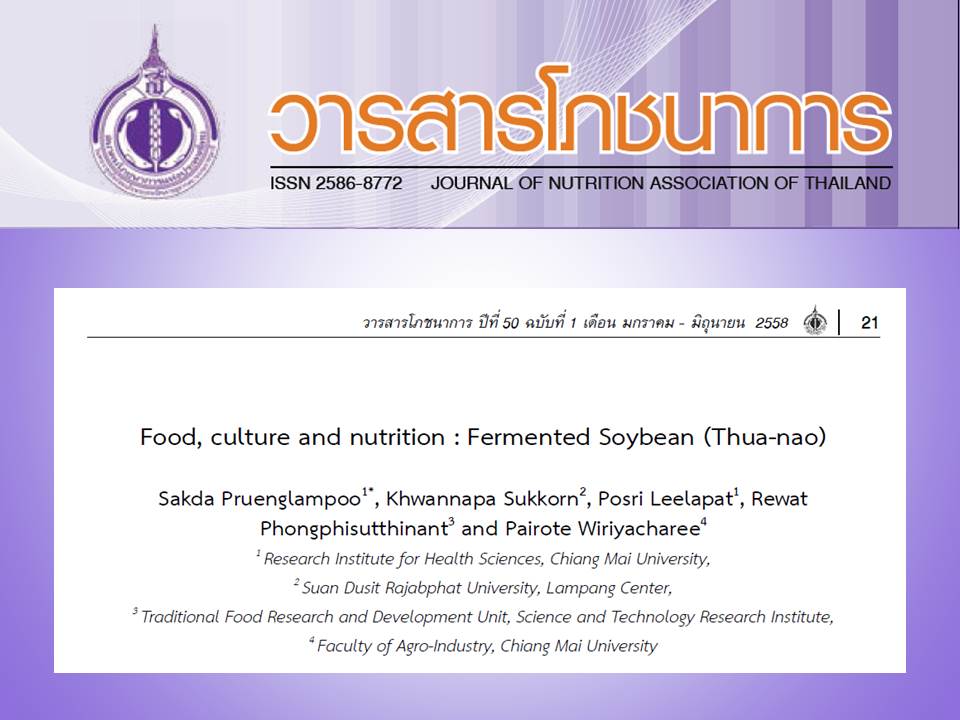Food, culture and nutrition: fermented soybean (Thua-nao)
Abstract
Thua-nao is a product of fermented soybean which is favorite food consumed among northern Thai people. Fermented soybean products of other ethnic groups, which have similar processing as Thua-nao, may have different characteristics found in a number of countries. There are two types of fermented soybean products: wet (Thua-nao muer) and dried (Thua-nao paan) types. The process of producing fermented soybean includes soaking raw soybean in water overnight, boiling in water for 3 to 4 hours, and keeping it for natural fermentation about 3 to 4 days. The bacteria occurs in fermented processing is Bacillus subtilis var. thuanao. To have the basic information regarding nutritive values of raw soybean and Thua-nao, which produced in the northern part of Thailand, not only leads to develop the good sanitation processing and increase nutritive values of Thua-nao but also keep local cultural food sustainable.
References
2. อารี ชูวิสิฐกุล, ปิติ กาลธิยานันท์. ถั่วเน่า…อาหารพื้นเมือง ภูมิปัญญาของคนไทยเมืองเหนือ. วารสารกรมวิทยาศาสตร์การบริการ. 2550;55(173):33-4.
3. จุฑารัตน์ สุภาษี. การผลิตและการบริโภคถั่วเน่าของกลุ่มไทยใหญ่ อำเภอแม่สะเรียง จังหวัดแม่ฮ่องสอน [วิทยานิพนธ์ปริญญาวิทยาศาสตร์มหาบัณฑิต]. เชียงใหม่: มหาวิทยาลัยเชียงใหม่; 2544.
4. ปฐมาภรณ์ วิโรจน์พันธุ์. ถั่วเน่าปรุงรสและกลิ่นหอมให้อาหาร. นิตยสารครัว. 2548;12(136):82-7.
5. ศักดา พรึงลำภู, ขวัญนภา สุขคร, ไพโรจน์ วิริยจารี และคณะ. โครงการพัฒนาคุณค่าทางโภชนาการของอาหารพื้นบ้านตามหลักปรัชญาเศรษฐกิจพอเพียง: ถั่วเน่า. เชียงใหม่: มหาวิทยาลัยเชียงใหม่; 2551.
6. Sneath PHA. Endospore-forming gram-positive rods and cocci. In: Sneath PHA, Mair NS, Sharpe MS, Holt JG, editors. Bergey’s manual of systematic bacteriology. 9th ed. Baltimore, MD: Williams & Wikins; 1986.
7. Steinkraus. Indigenous fermented foods involving an alkaline fermentation. 2nd ed. NY: Marcel Dekker; 1955.
8. Messina M. Role of soy in promoting health. Food focus Thailand industry focused magazine for F&B professionals. 2007;2(12):24-7.
9. Murphy PA, Barua K, Hauck CC. Solvent extraction selection in the determination of Isoflavones in soy foods. J Chromatogr B Analyt Technol Biomed Life Sci. 2002;777(1-2):129-38.
10. Carrao-Panizzi MC, Bordingnon JR. Activity of beta-glucosidase and levels of isoflavone glucosidases in soybean cultivars affected by the environment. Pesq Agropec Bras. 2000;35(5):873-8.
11. Choi YB, Kim KS, Rhee JS. Hydrolysis of soybean isoflavone glucosides by lactic acid bacteria. Biotechnol Letters. 2002;24:2113-6.
12. Anderson RL, Wolf WJ. Compositional changes in trypsin inhibitors, phytic acid, saponins and isoflavones related to soybean processing. J Nutr. 1995;125(suppl):581-8.
13. Xinhua Y, Vyn TJ. Relationships of isoflavones, oil, and protein in seed with yield of soybean. Agron J. 2005;97:1314-21.
14. Nelson KA, George ER, Teak EN. Effect of Lactofen application timing on yield and isoflavone concentration in soybean seed. Agron J. 2007;99:645-9.
15. Arthur CE, William FK. Soybean isoflavones: effect of environment and variety on composition. J Agric Food Chem. 1983;31:394-6.
16. Hong K, Lee C, Kim SW. Asperillus oryzae GB-107 fermentation improves nutritional quality of food soybean and feed soybean meals. J Medicinal food. 2004;7(4):430-6.
17. Chukeatirote E, Thakang P. Chemical composition of thua nao-a fermented soybean food of northern Thailand. Chiang Mai J Sci. 2006;33(2):243-5.
18. Sarkar PK, Tamang JP, Cook PE, Owens JD. Kinema-a traditional soybean fermented food: proximate composition and microflora. Food Microbiology. 1994;11(1):47-55.

Downloads
Published
How to Cite
Issue
Section
License
Upon acceptance of an article, copyright is belonging to the Nutrition Association of Thailand.


